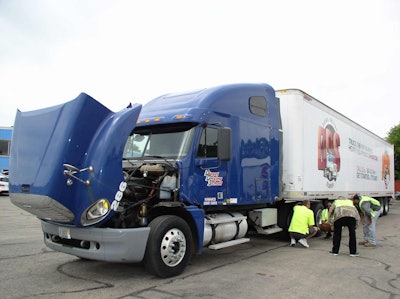
PTDI’s letter also urges the agency to reconsider the decision to exclude a set minimum behind-the-wheel time from its final rule on training requirements published in early December. As most of you will know, the agency entered into a negotiated rulemaking process to develop the rule, which brought together various industry stakeholders forming an Entry-Level Driving Training Advisory Committee (ELDTAC). The consensus reached by ELDTAC, on which PTDI was a participant, as the institute notes, included the requirement that applicants for a commercial driver’s license (CDL) receive a minimum 30 hours of behind-the-wheel (BTW) instruction for Class A CDL applicants, along with minimum competency requirements.
The final rule, however, excluded a BTW minimum requirement, despite the consensus reached (with just a couple of dissenters). PTDI stakeholders, the institute says, feel much the same as a lot of truckers: “very disappointing,” essentially, they said.
Opposition to a BTW minimum came from the American Trucking Associations, according to the final rule, likewise a range of other businesses and organizations (many of them ATA members) that argued setting a minimum at 30 hours was arbitrary.
ATA was a member of the committee that negotiated the rulemaking to begin with, and in comments on the final rule favored a performance-based approach — if the trainer is willing to sign off on a pre-CDL driver’s abilities to perform the necessary maneuvers safely in any amount of BTW training sessions, he or she should be allowed to advance to the skills test to get his/her CDL, such reasoning goes.
Further, as FMCSA specified in the finale rule’s discussion of comments against the BTW minimum, ATA “viewed the proposed BTW hours requirement as … not supported by any research indicating ‘a relationship between the number of hours spent in training and a reduction in crashes.’ Noting that ‘what little data is available does not support a minimum hours-based approach,’ ATA cited the American Transportation Research Institute’s (ATRI) 2008 analysis of the effect of CDL driver training on safety performance.”
While the rule does require BTW curricula to be demonstrated while any trainee “has actual control of the power unit during a driving lesson on a … public road,” the rule notes, thus requiring at least some road training, FMCSA justified its decision to remove the 30-hour BTW requirement from the pre-CDL training negotiated rulemaking in part following ATA’s logic. As excerpted from the Final Rule’s text:
The Agency’s conclusion that the final rule should not, at this time, impose a mandatory minimum number of BTW hours for the Class A and Class B training, is primarily due to the fact that, despite the best efforts of FMCSA and the ELDTAC, we were not able to obtain sufficient quantitative data linking mandatory minimum BTW training hours with positive safety outcomes, such as crash reduction, following publication of the NPRM.
Consistent with the Agency’s objective to produce data-driven regulations that balance motor carrier safety with efficiency, FMCSA has long recognized the value of quantitative correlative evidence supporting ELDT.
Previous attempts to develop an entry-level training rule were unsuccessful in part for some of the same reasons — a lack of data, all of which reminds me of what Western States Trucking Association’s Joe Rajkovacz noted about the issues with the rule in total at the ELDTAC’s first meeting — the lack of a lot of data showing training’s correlation with later on-highway safety.
PTDI, with its letter to FMCSA urging reconsideration of the BTW minimum, however, noted it believed and was “concerned, particularly, that the apparent reasoning for omitting the BTW requirement was the Office of Management and Budget’s (OMB) determination that it would create an undue cost burden on schools,” according to PTDI’s press release about its letter earlier this week. FMCSA’s
Quality training programs, it goes on to note, already require BTW time, and some states require it. PTDI, in its minimum standards, has specified not only additional BTW hours, but provided additional requirements for specific skills:
- 44 hours (60-minute hours) per student overall with 12 of those on the highway [public roads], including six hours with a 15,000-pound minimum load, and 32 hours that may be on the range, highway or a combination range/highway.The 44 hours also include a minimum of one hour of night driving practice.
- Included in the 44 BTW hours are 24 hours of Basic Operations, 17 hours of Safe Operating Practices for basic operations and three hours of Advanced Operating Practices.
“The purpose of establishing entry-level training standards for commercial drivers,” PTDI’s release concludes, “is to reduce programs that are turning out inadequately trained and prepared drivers, who pose a risk to public safety. This has been the foremost goal of PTDI since its inception – to assure drivers are fully prepared to take on the serious responsibility of driving a heavy vehicle on our nation’s highways – and PTDI firmly believes that BTW time is critical to achieving that goal.”
FMCSA, for its part, notes in the final rule that “Our decision not to include the minimum BTW hours as part of the Class A and B curricula should not necessarily be construed as the Agency’s last word on this subject.”
Stay tuned… What’s your view?










